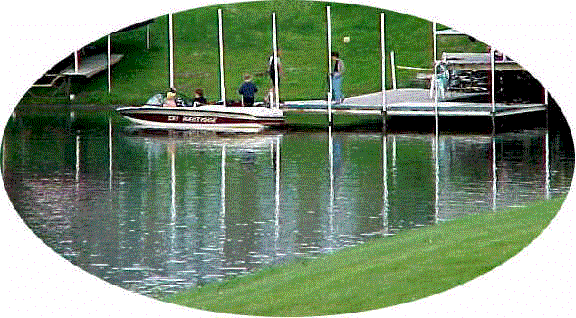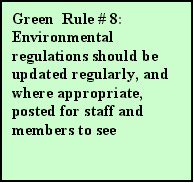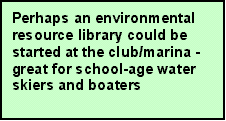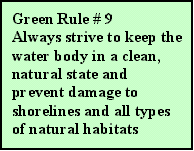
International Water Ski Federation
Environmental Handbook for Towed Water Sports


If you are a club/marina operator and
are looking for practical advice on environmental management strategies, this
section will help you get started.
The term ‘environmental management’
is used broadly to describe the process of managing an activity or program that
ultimately has one or more benefits for the natural environment.
This can be as simple as providing a spill prevention course for
club/marina staff to implementing a comprehensive top to bottom Environmental
Management System (discussed below).
Regardless of the extent of the program,
the important fact is that steps are being taken today to minimize the
environmental impacts of tomorrow.
If a comprehensive, top to bottom
management approach is what your club/marina
requires, then an Environmental Management System (EMS) is an excellent
tool to help you achieve a high level of environmental performance.
Today, organizations of all types and sizes are implementing EMSs. There are several options as to how to implement an EMS. They range from hiring a consultant, to doing it on your own, to being part of a government or university case study program. There are also journals, publications, and public information on EMS from environmental groups and government agencies. The challenge for you, the operator, is in the practical implementation of an EMS.
An EMS guides the user through a series
of logical, interconnected steps based on well thought-out goals and objectives
intended to address one or more environmental issues. While there are minor variations in different EMS models,
they are all very similar in the main components and overall objectives.
The following is an outline of the main
components of an EMS model:
·
Management
Support –
ensure that all key decision-makers endorse the program?
·
Statement
of the Issue
– develop clear definition of the issue and its impact(s)
·
Program
Leader –
point person who drives program and oversees its progress
·
Regulations
--
list all that apply to issue and incorporate into strategy
·
Goals
and Performance Targets –
establish realistic goals and performance targets for each issue
·
Implementation
Strategy –
develop strategies to meet performance targets within a time frame?
·
Performance
Measures –
establish benchmarks by which to measure progress
·
Resource
Needs –
determine resource requirements within a realistic time frame
·
Observe
and Record –
monitor progress and maintain accurate records
·
Educate
and Communicate – inform and
educate staff, members, other stakeholders
about issues, strategies, and how they can contribute to the program
·
Review
and Improve --
establish regular review periods and make changes as needed
·
Fund
Raising and Promotion
– develop strategies to fund and/or promote the program if necessary.
Preparatory work is important as it
helps prevent misunderstandings and setbacks, and lays a foundation for
long-term program success. It
can also have other additional benefits such as cost savings, overall improved
operating efficiencies, improved public image for club/marina, and enhanced
member pride.
The following headings cover the main
areas of operation for club/marina operators, and include suggested best
practices for preventing or minimizing environmental impacts.
One of a club/marina’s best security
blankets is its Codes of Practice. Codes
provide members and the public a clear understanding of the club/marina’s
guidelines, restrictions, and rules of membership for safe, responsible boating.
Codes of Practice are invaluable tools as they:
· Set the boundaries of acceptable behaviour both on and off the water
· Demonstrate the marina’s commitment to the environment
· Help reduce the marina’s liability and risk
· Demonstrate the marina’s commitment to safety both on and off the water
· Demonstrate to the local community that the marina upholds principles of sound management and respect for the environment
· Demonstrate sensitivity and respect for neighbours and other waterway users
·
Demonstrate a level of professionalism and due
diligence many potential sponsors value
All
Codes of Practice should be posted in the clubhouse and dock areas, and
communicated regularly through the appropriate club/marina publications.
As part of a Code, some clubs/marinas have developed policy statements
and agreements for members to sign that demonstrate a commitment to clean and
safe boating practices. A sample of such a policy and agreement can be found in
Appendix E.
For a sample outline of a Code of Practice, produced by Britain’s Sports Council, and a Code of Conduct for Noise, produced by the British Water Ski Federation, refer to Appendix C.
2.
ENVIRONMENTAL REGULATIONS:
To reduce and eliminate risk and
liability a club/marina must be fully aware of all
environmental legislation and regulations related in any way to its
activities, services and products. This
also includes proposed or draft legislation. 
Not only does this awareness help
the marina address environmental liability issues, but it also provides lenders,
employees, and other stakeholders evidence of sound environmental performance.
Management is advised to check with local authorities and government
agencies on a regular basis to make sure that they are current on proposed
legislation.
All regulations and by-laws which affect
boaters, water skiers, and members should be posted, printed in marina
literature, included in member contracts, and updated regularly.
3.
ECOLOGICAL ISSUES – Addressing the Impacts:
Operators
should at a minimum be aware of the types of ecological impacts associated with
the club/marina’s land and water-based activities. With some issues, and in certain bodies of water, these
impacts may be well known and documented, while with others there may be no
awareness or history of reporting.
It is to
your advantage to be as knowledgeable as possible about the impacts – not only
will it demonstrate a level of responsibility but you will also be prepared to
respond publicly if the issue were to become controversial.
It also provides you with a strong base of knowledge when the time comes
to choose a strategy to minimize or prevent the impact.
It is
helpful to put together a list of the most commonly known impacts and start a
file on each. This is a great
opportunity to seek input from other "stakeholders"/interested
parties, such as members, the local cottage association, or conservation group,
and invite them to be part of an environmental team.
If more
information is required on an impact, the following sources may be helpful:
·
Government bodies
responsible for environment and land use –all recent
biological and environmental reports undertaken on area
·
Local library
·
Local and/or
national environmental groups
·
Local and/or
national conservation groups
·
Local and/or
national interest groups
·
Private developers
that have worked near shoreline or in general vicinity
·
Universities or
Colleges – potential source for biological or environmental studies
Maintaining files on each impact is beneficial because they:
·
Provide management
with a recorded history of the issues
·
Reduce the
marina’s environmental risk through sound record keeping
·
Involve
stakeholders, and potential funding partners, in pursuit of common environmental
goals
·
Influence the type
of remedial steps taken
·
Can be used as
educational material for teaching young and old boaters and skiers
If you are not sure where to begin, you may want to consider one or more
of the following:
· Hire an environmental consultant to perform study and develop recommendations
· Undertake work on your own with professional input where necessary
· Seek assistance from affiliated organizations, such as your national water ski federation, the IWSF, or other boat or ski groups
· Partner with academic institutions to undertake study (i.e. a graduate degree project)
·
Approach local government for funding or to
undertake study
If your
time and resources are limited, a volunteer committee could be struck to manage
the program. If well organized, a
volunteer program is not only cost effective but it provides people
opportunities to get involved. However,
as with staff, a volunteer driven program still requires guidance, direction,
review and recognition on a regular basis.
Dock and yard management is an important
issue for a club/marina as they are two of its most visible assets.
They are also the busiest, and potentially the most hazardous areas of
the club/marina. Sound dock and
yard management is not only important for environmental and safety reasons, but
also for attracting new business.
Typically, the dock area provides the
following services to the club/marina:
· Fuel dock
· Pump-out facility
· Launching and Storage
· Grounds Maintenance
· Water body usage i.e. water skiing
Each of these
services has the ability to affect the environment and therefore they are
addressed individually.
FUEL Dock:
One of the most
common and severe risks that occur in the dock area is the spill of hydrocarbons
(oil, gasoline, and diesel) in the water, on land, and in the atmosphere (see
Appendix A for details of impacts). Another risk in the fuel dock area is fire -
a potentially devastating threat intensified by poor fueling techniques.
The following are
recommended best practices for dock management:
SAFE Practices for Dock Managers:
·
List proper re-fuelling practices including safety issues
·
Comply with the requirements of relevant fuel handling codes and
regulations
·
Provide clear instructions for reporting spills
·
Indicate location of absorbent materials and instructions for their use
·
Make sure instructions are readily visible to boaters
GENERAL
Rules for Pump-Out Facilities
The
following are some basic rules for the management of pump-out facilities:
· The pump-out facility shall be available and in good operating condition at all times. If it is not, customers should be asked to inform management immediately
· Customers should be informed of what practices are and are not permitted
· Ensure that the tank is pumped out regularly – don’t wait until the tank is full before calling a licensed sewage haulage contractor
· If a pump-out facility is not on site, management must indicate the nearest location
· Suction and washout hoses should be clearly marked and their storage position clearly labeled. Coil and hang the wash-water hose beside a sign which states that the water from that hose is NOT A DRINKING WATER SUPPLY
· Location of onshore toilet facilities should be clearly indicated
·
Check the pipes from the dock pump-out station
regularly for damage and leaks
Some of the
impacts associated with launching and
retrieving boats include the release
of hydrocarbons (gas, oil, and diesel) and heavy metals into the water,
atmosphere and on the ground. Also,
the transfer of unwanted marine organisms, or biological contaminants, can be
prevented before boats are put onto the trailers.
The following are some best practice
tips for safe launching and retrieving:
· Keep fuel, oil, grease and heavy metals out of the water
· Help members reduce their launching time whenever possible. Explain that oil, grease and other contaminants may drip from the hull into the water
· Remove boats from the ramp as quickly as possible to minimize oil and grease spills
· Avoid leaving the travel hoist parked over the haul-out dock when not in use to minimize the chance of hydraulic oil and grease dripping into the water. The hoist must be well maintained to prevent leaks.
· Boats should be removed from the haul-out slip area to a designated wash area before hulls are power washed. Only light hosing or hand washing should be done in the ramp and haul-out areas
· Encourage members to keep trailers well maintained and free of excessive oil and grease
·
Encourage members to use vegetable-based
greases for trailer wheel bearings
Similarly, storage of boats and liquids can also lead to release of hydrocarbons and heavy metals due to leaks. And, the storing of boats can be done without the creation of unnecessary solid wastes.
The following
are some best practice tips for boat storage:
· Ensure stern drive units and outboard engines are not leaking
· Place drip trays under grease-filled stern tubes
· Place drip trays under stern drives and outboards
· Add inhibitors to the gas tank before long term storage to stabilize the fuel
· Ensure that fuel tank suction line valves are closed where appropriate
·
 Encourage boat owners to
use tarpaulins or invest in a canvas boat cover that can be reused over and over
Encourage boat owners to
use tarpaulins or invest in a canvas boat cover that can be reused over and over
· If possible, restrict the use of shrink-wrap in the absence of a recycling contract with the supplier as part of the standard service
· If shrink-wrap is being used, be sure to tape over all fuel vents before igniting heat gun
For the storage of liquids make sure to:
· Check the condition of fuel lines to the gas dock
· Check the condition of above ground tanks and secondary containment walls for damage and/or corrosion
· Check that the drain valves to the secondary containment are kept closed
· Verify that the fuel pumped at the gas dock corresponds to changes in tank levels. This should be done on a daily basis during the season and once a month out of season. When dipping, look for water in the tank as well as checking the fuel level
·
Always have someone standing by when fuel tanks
are being refilled
The grounds of a club/marina include
everything from roads, parking, and outdoor storage to drainage, grass,
buildings and utilities.
The following are some suggested best practices for grounds maintenance:
·
Allow the grounds to grow as naturally as possible and
explain this to the members
· Avoid or at least minimize the use of toxic herbicides and pesticides for weed and insect control – use biological means of control whenever possible
· Do not cut grass more often than necessary and leave all grass at least 5cm long
· Cut grass only where necessary for recreational purposes
· Do not water more often than absolutely necessary
· Maintain a natural buffer area wherever possible between marina and the shoreline. This will help to restrict storm-water runoff and will improve visual impact of club/marina
· Keep storm-water gullies clear of debris and grass well groomed
· Encourage members to enjoy the wildlife that will be attracted
· Ask members to avoid throwing food and fish scraps that may attract unwanted wildlife pests. Also, discarded fish parts can lead to a reduction in the oxygen content of the water and foul smells
· Provide members a fish cleaning station with a closed lid container for fish scraps.
· Ensure that fish cleaning station has running water and filtered drain that leads into sewer drain—do not allow fishy water to drain into water body
· Provide members with baggies for cleaning up after pets and encourage them to take pets far from recreational and work areas
· Collect and properly dispose of garbage regularly
· Maintain granular surfaces to maximize storm water absorption and minimize runoff
· Use only vegetable-based liquids (such as black liquor from the pulp and paper industry) or calcium for dust suppression.
· Use only environmentally acceptable cleaners and disinfectants for buildings and washrooms – avoid flushing any chemicals as they may be toxic to the bacteria that keep a septic system functional.
· Avoid using any air conditioning units that produce chlorofluorocarbons (CFCs)
· Do not let refrigerant gases be released during maintenance of air conditioning units
· Maintain all machinery in good working condition and repair all leaks immediately
· Provide drip trays or other containment wherever leaks occur in machinery
·
Use vegetable-based greases where possible
We all have a responsibility to keep the water body in as natural, and clean a state as possible. While the majority of the evidence finds that boating and water skiing has a minimal impact on aquatic ecosystems, there are also studies that find that boating activity can have a significant impact on certain aquatic environments.
The
following are suggested best practice tips to prevent damage to the water body:
· Do not allow members to operate boats, or water ski at high speeds in shallow waters (a minimum level in some areas is 1.5 metres) – not only does it cause turbidity and destroy fish habitats, but it is very dangerous where there are swimmers in the water
· Put in place no-pass zones to prevent shoreline erosion from wash especially if shorelines do not have natural or artificial reinforcement or protection barriers. It can also damage boats moored on outer docks of some club/marinas
· Put in place controls to prevent excessive noise (as in Code of Conduct for Noise)
· Inform customers that they are responsible for their own waste management and request that they use the club/marina facilities and containers for appropriate wastes
· Introduce a Safety Education Program for water skiers and boaters
Create an Awards Program to recognize members for excellence in boat and ski safety and environmental responsibility.
To control aquatic plant growth around dock and the shoreline certain
precautions can be taken including: 
· Obtain appropriate permits for weed removal from government, if necessary.
· Keep plant removal to a minimum—in some areas the removal of a small amount can have a detrimental effect on a marine environment
· Be aware of periods when fish spawn in order to protect spawning habitats
· Avoid use of herbicides and pesticides – some jurisdictions ban such chemicals
·
Use mechanical methods, such as boat-mounted
cutters, to cut back excess plant growth where possible and practical.
The plant debris should then be collected and composted at a suitable
composting site away from recreational areas.
· Dredging should be avoided as much as possible – it destroys habitats and breeding areas for fish, amphibians and other organisms. It can also disturb harmful contaminants that may have settled in the sediments and affect water quality
·
All dredged material must be disposed of on
land and suitably contained to prevent it from washing back into the water
Implementing a waste prevention program
is usually simple and, if done correctly, cost effective.
The 4R philosophy should be promoted and members encouraged to reduce
wastes in every way possible.
A waste prevention program can provide the following benefits:
· Reduction in use of raw materials
· Cost savings from reduced waste disposal fees
· Conservation of valuable resources
· Reduced pollution and enhanced visual impact
· Improved public image and employee pride
· Compliance with regulations and reduced liability
The Waste Audit
One of the best
steps to take before implementing a waste management program is to conduct a
waste audit at your club/marina. This
is a simple procedure that will tell you what categories of waste are being
generated and in what volumes. The
findings become the benchmarks upon which realistic waste reduction targets can
be set and measured against.
For an outline of
a waste audit please refer to Appendix D.
WASTE Collection -- Non- Hazardous:
Once management
has determined what the waste categories will be, separate containers for
garbage, recyclable materials, and reusable items should be set up side by side,
at convenient locations around the marina.
Members and other
club users should be encouraged to participate in the recycling program.
This requires plenty of easy to read informative signs and containers
placed in convenient locations. This program also demands that the containers be emptied on a
regular and/or as needed basis.
WASTE Management Practices for
Operators:
· Ensure that containers have lids that are in place
· Ensure that containers for recyclables are clearly labeled
· Ensure that containers are emptied into the dumpster regularly
· Keep collection areas neat and tidy
· Ensure that lids on dumpsters are kept closed
· Ensure that dumpsters drains are kept closed
· Call the waste hauler for pick-up before the container is completely full
·
Always set a good example by picking up waste
and keeping the marina premises tidy.
MEMBERS
and Customers:
· Members should be discouraged from taking packaging and other waste onboard.
· Members should be offered onboard containers for their recyclables
· Do not allow members to pour waste liquids into any solid waste containers
· Do not allow members to put waste directly into the dumpster. Management should know and control what goes into the dumpster.
·
Management can offer a service to collect all
liquid wastes from the boats. This
will prevent contamination of valuable recyclables and of dumpster
WHAT
Qualifies as Hazardous Waste?
A hazardous waste can be either liquid or solid and is usually labeled
as hazardous in print, by universally recognized symbols.
The other ways to properly identify a hazardous waste include:
·
Examine the Material
Safety Data Sheet (MSDS) supplied with the material.
MSDS describe the physical and chemical nature of the substance and the
methods for proper handling, storage and disposal.
·
Contact the
manufacturer of the product
·
Contact the local
government office responsible for the environment and waste management
·
Obtain a copy of a
registration guidance manual for generators of liquid industrial waste and
hazardous waste usually available from government offices.
SAFE
Hazardous Waste Handling Practices:
·
Register as a
generator of hazardous waste (depending on local government regulations)
·
Ensure that the
hazardous wastes are collected regularly by a registered hauler
·
Ensure that each
shipment is properly manifested.
WISE Storage
Practices for Hazardous Materials:
·
Place materials that
are contaminated with a hazardous substance in tightly closed containers of a
compatible material (refer to MSDS for guidance)
·
Keep hazardous
chemicals separated according to their classes
·
Keep hazardous
wastes in separate containers that are clearly labeled with their contents prior
to being disposed of in a proper manner
·
Minimize the amount
of materials stored on site
·
Ensure that the
storage location for hazardous materials is out of high traffic areas and can be
secured from public at all times
The contracted waste hauler should be asked to assist in the preparation
of both the waste generator registration report and the manifests.
This co-operation will be of benefit to both parties in ensuring that the
documentation correctly identifies the waste to be transported.
WASTE
Collection – Hazardous Waste:
All persons who use a marina should be aware that some materials are
considered to be hazardous wastes and are regulated accordingly.
Such materials must be segregated and collected separately.
Management would also be wise to check periodically with local
environmental organizations for suggestions on alternative products, and where
applicable, with government departments that have a labeling program for
environmentally approved products or services.
One of the best
ways to determine if a club/marina could be more energy efficient is to
undertake an energy audit. The
audit should be carried out by someone with an understanding of the various
energy systems of the club/marina, or by an energy consultant.
In many countries there are private companies who will undertake an
audit, retrofit a facility, and arrange for financing based on the savings
accrued over time from the retrofit.
To find such an
energy consultant check with your local government agency, hydroelectric
commission, or energy association. A
search of the internet may also prove worthwhile.
ENERGY
Efficiency Practices:
Management should
have a good understanding of what operations consume energy,
how much energy is used, and at what times during a 24-hour period.
An energy audit is the best way to reveal this, while simple things, like
monthly hydroelectric bills, can help pinpoint general energy consumption practices.
The following are
some energy saving tips for a club/marina and its facilities:
DOCK Area:
· Provide a metered electrical supply to individual docks to encourage energy savings
· Provide customers with magnetic identity cards to use the toilet facilities where possible
·
Turn off unnecessary lights--operate area
lighting on automatic timers or motion sensors
OFFICE:
· Turn off unnecessary lights--operate area lighting on automatic timers or motion sensors
· Use only enough wattage per bulb as necessary
· Turn off all computers and other office machines when not in use
· Use high quality, energy efficient lighting throughout offices – compact fluorescent bulbs use 70% to 80% less energy than regular light bulbs
· Plant deciduous shade trees near windows to reduce demand for air conditioning in summer, and heat in the winter months by allowing sun through windows
· Attach awnings outside and curtains (or blinds) inside to reduce demand for air conditioning and heat in summer and winter months
· Use fans instead of air conditioning if possible – fans use less energy and do not contain the ozone depleting coolants that many air conditioners require (like chlorofluorocarbons)
YARDS
and Grounds:
· Where possible, use hand operated equipment over power tools or vehicles
·
Let grass areas grow longer and cut less
frequently to reduce use of electric mowers
EDUCATION and Communication Programs:
Effective education and communication strategies can
be critical to the success of an environmental program.
They inform members and in turn encourage them to participate.
They can also ensure a minimum level of compliance by all, and make the
enforcement of Codes of Conduct by management and staff much easier.
Water skiers and boaters need to know what the
environmental issues are, and how their activities contribute to the impacts.
And importantly, they need to be informed in a constructive way as to
what steps they can take to prevent further impacts.
A Communications
Committee made
up of volunteer members is one way to develop a communications strategy.
This committee would be responsible for making sure that the correct
messages are getting out and in a timely manner.
Some of the information vehicles at their disposal may
include:
·
Provide regular updates to members through club/marina newsletter
·
Ensure a staff member is on the Committee to ensure all staff are
informed
·
Create an environmental section on club/marina notice board
·
Use posters and flyers
·
Make announcements over public service system
·
Place inserts into regular club/marina mail outs
·
Use member internet e-mailings and a club/marina web site
·
Annual reports
The Communications Committee can oversee a staff awareness program and
make sure that required protocols, like Emergency Spill Plans, First Aid, or
Hazardous Waste Management Procedures are updated, well communicated, and
visible to all affected.
Management and its Committee members may also want an
external communication plan
to inform sponsors, the boating/water ski public, and other stakeholders about
the environmental programs. A
separate mailing may be the way to communicate with some of these audiences, or
any of the above listed vehicles could also be used.
MONITOR
and Review:
In order to assess a club/marina’s environmental performance, regular
record keeping should be maintained. This
will provide results, allow managers to spot weak areas, and provide the
benchmark for setting new goals.
Furthermore, a regular review period of all environmental programs is
wise as it will help club/marina operators measure performance, control
spending, and ensure that performance targets are being met.
RECOGNITION
and Awards:
Last,
but certainly not least, is a reminder to recognize all those who contribute to
the environmental management program. Some
organizations create awards to recognize staff and volunteers who made a
valuable contribution to an environmental goal. Some possible awards include:
Best Boat Driver
Lowest Marine Engine Emission
Quietest Marine Engine
Green
Volunteer Award
An
environmental management program is an excellent way for a club/marina to
introduce a range of stakeholders to the world of water skiing and boating and
strengthen bonds within the community. Their
assistance can sometimes make an environmental program truly successful.
Expressing gratitude to these persons is not only the right thing to do,
but good public relations for the club/marina and the sport of water skiing.
Waterskiing, Boating and the Environment - Part B
Practical Steps to Environmentally Responsible Water Skiing and Boating - Part C